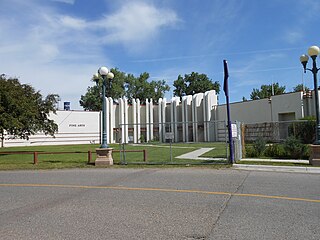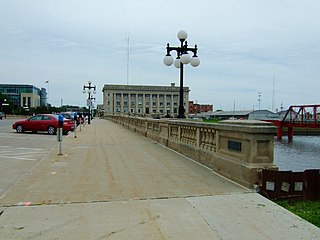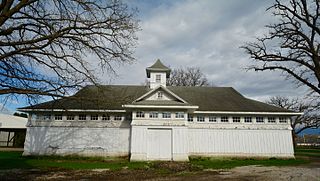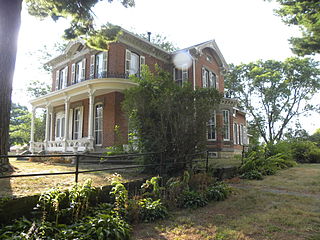
Des Moines is the capital and most populous city in the U.S. state of Iowa. It is the county seat of Polk County with parts extending into Warren County. It was incorporated on September 22, 1851, as Fort Des Moines, which was shortened to "Des Moines" in 1857. It is located on, and named after, the Des Moines River, which likely was adapted from the early French name, Rivière des Moines, meaning "River of the Monks". The city's population was 214,133 as of the 2020 census. The six-county metropolitan area is ranked 81st in terms of population in the United States, with 709,466 residents according to the 2020 census by the United States Census Bureau, and is the largest metropolitan area fully located within the state.

The Minnesota State Fair is the state fair of the U.S. state of Minnesota. Also known by its slogan, "The Great Minnesota Get-Together", it is the largest state fair in the United States by average daily attendance and the second-largest state fair in the United States by total attendance, trailing only the State Fair of Texas, which generally runs twice as long as the Minnesota State Fair. The state fairgrounds, adjacent the Saint Paul campus of the University of Minnesota, are in Falcon Heights, Minnesota, midway between the state's capital city of Saint Paul and the adjacent city of Roseville, near the Como Park and Saint Anthony Park neighborhoods of Saint Paul. Residents of the state and region come to the fair to be entertained, exhibit their best livestock, show off their abilities in a variety of fields including art and cooking, learn about new products and services, and eat many different types of food—often on a stick. The Minnesota State Fair was named the best state fair in the United States in 2015 by readers of USA Today.

The Iowa State Fair is an annual state fair held in Des Moines, Iowa in August.

Kansas State Fair is a state fair held annually in Hutchinson, Kansas, United States. It starts the Friday following Labor Day in September, and lasts for 10 days. This fair is the largest single event in the state and attracts approximately 350,000 people annually. The fairgrounds is centered at 23rd Ave between Main and Plum Street in Hutchinson, and consists of over 70 buildings on 280 acres (110 ha). It has full-time year-round staff. The 2023 Fair will be held from September 8 to 17.

The Ohio State Fair is one of the largest state fairs in the United States, held in Columbus, Ohio during late July through early August. As estimated in a 2011 economic impact study conducted by Saperstein & Associates; the State Fair contributes approximately 68.5 million dollars to the state's economy. In 2015, attendance was 982,305, the Fair's highest 12-day attendance on record.

James Barney Marsh was an American engineer and bridge designer. He patented a new design for arch bridges. Marsh gave Archie Alexander, the first African-American to graduate as an engineer from Iowa State University, his first job. Marsh worked in the bridge building business for over 50 years, and several of his bridges are listed in the National Register of Historic Places.

Historic East Village is a commercial and residential neighborhood in central Des Moines, Iowa, United States, directly east of the Downtown Des Moines area. The neighborhood is bounded by Interstate 235 on the north, the Des Moines River on the west and south, and East 14th Street on the east. It also sits adjacent to the Historic Court District, which sits west across the Des Moines River. Part of the East Village forms a nationally recognized historic district that was listed on the National Register of Historic Places in 2019.
The Midwest Electric Railway is a non-profit trolley operation located on the grounds of the Midwest Old Threshers Reunion in Mt. Pleasant, Iowa, United States. It is home to 10 pieces of trolley history that are regularly operated on a 2.5 mile loop surrounding the organization's campgrounds.

Proudfoot & Bird was an American architectural firm that designed many buildings throughout the Midwest region of the United States. Originally established in 1882, it remains active through its several successors, and since 2017 has been known as BBS Architects | Engineers.

The Des Moines City Hall is a government building in Des Moines, Iowa, built in 1909 and 1910. It was individually listed on the National Register of Historic Places on November 10, 1977 as the Municipal Building, and became a contributing property in the Civic Center Historic District in 1988. The building serves as the seat for the government of the city of Des Moines. Beginning April 7, 2016, City Hall offices were temporarily relocated while the building underwent renovation. The construction was necessary to install modern heating, cooling, and sprinkler systems while preserving the historic character of the building. The project was expected to take 18–24 months. During that time, City Hall was closed to the public, and City offices moved to other nearby locations. Between February 26, 2018 and April 9, 2018, city offices moved back to City Hall.

The Montana ExpoPark is a fairground located in the city of Great Falls, Montana, United States. The 133-acre (54 ha) grounds contain 35 buildings, a horse racing track, grandstands, and the Four Seasons Arena—multi-purpose sports and exhibition arena. The site is the host of the Montana State Fair as well as agricultural shows, rodeos, basketball tournaments, and funfairs. The six original structures of the fairgrounds were added to the National Register of Historic Places in 1989.

The Chautauqua Park Historic District is located on the north side of Des Moines, Iowa, United States. It has been listed on the National Register of Historic Places since 1990. It is part of the Suburban Development in Des Moines Between the World Wars, 1918--1941 MPS.

The Civic Center Historic District is located in downtown Des Moines, Iowa, United States. It flanks both the Des Moines and Raccoon Rivers and their confluence. The district has been listed on the National Register of Historic Places since 1988. It is part of The City Beautiful Movement and City Planning in Des Moines, Iowa 1892—1938 MPS.

The Kingman Place Historic District is located in Des Moines, Iowa, United States. The historic district contains a well-preserved collection of American Foursquare houses that were built starting in 1902 and continued until 1915. It has been listed on the National Register of Historic Places since 2000. It was part of The Bungalow and Square House--Des Moines Residential Growth and Development MPS.

The Fish and Game Pavilion and Aquarium is located in the Iowa State Fairgrounds in Des Moines, Iowa, United States. The structure was erected with financial support from the State of Iowa. It was designed by the Des Moines architectural firm of Proudfoot, Rawson & Souers. It is a masonry building with a steel frame structural system and exhibits eclectic, Italian Renaissance detail. It was originally built from 1926 to 1927 and was expanded in 1929. The building was listed as a contributing property on the National Register of Historic Places in 1987 as a part of the Iowa State Fair and Exposition Grounds and it was individually listed in 1991 as a part of the Conservation Movement in Iowa MPS.

Hallett & Rawson was an architectural partnership in Iowa. George E. Hallett and Harry Rawson were partners. BBS Architects | Engineers is the continuing, successor firm; its archives hold plans of the original Hallett & Rawson firm. Works by the individual architects and the firm include a number that are listed on the National Register of Historic Places.

The Muscatine County Fairgrounds are located in West Liberty, Iowa, United States. It hosts the annual Muscatine County Fair. The Muscatine County Historic Preservation Commission received a grant from the State of Iowa to study the fairgrounds in 2014. Most of it was listed as a historic district on the National Register of Historic Places as the West Liberty Fairgrounds Historic District in 2015. At the time of its nomination it consisted of 42 resources, which included 16 contributing buildings, two contributing sites, two contributing structures, 16 non-contributing buildings, and six non-contributing structures. Historic tax credits will be used to rehabilitate the historic buildings on the fairgrounds.

Briggs Terrace, also known as Evergreen Lane, is a nationally recognized historic district located in Nevada, Iowa, United States.

St. Augustin Catholic Church is a Catholic parish in the Diocese of Des Moines located on the west side of Des Moines, Iowa, United States. It was included as a contributing property in the Greenwood Park Plats Historic District and listed on the National Register of Historic Places in 2013.

The Greenwood Park Plats Historic District is a nationally recognized historic district located in Des Moines, Iowa, United States. It was listed on the National Register of Historic Places in 2013. At the time of its nomination the district consisted of 393 resources, including 277 contributing buildings, one contributing site, 109 non-contributing buildings, and six non-contributing structures. Most of this district was originally known as Brown's Park, a private park that was the location of the Iowa State Fair from 1879 to 1885. Founded privately in 1854, the fair was held in several locations in the state making it more of a regional event. It was also not profitable. That changed when the fair moved to this location, and its profitability eventually led to funding from the Iowa General Assembly and a permanent location on the east side of the city. Brown's Park continued for a while longer and the streetcar line from Des Moines opened in 1889.
























